key PONTIAC GRAND AM 1998 Owner's Guide
[x] Cancel search | Manufacturer: PONTIAC, Model Year: 1998, Model line: GRAND AM, Model: PONTIAC GRAND AM 1998Pages: 370, PDF Size: 16.11 MB
Page 126 of 370
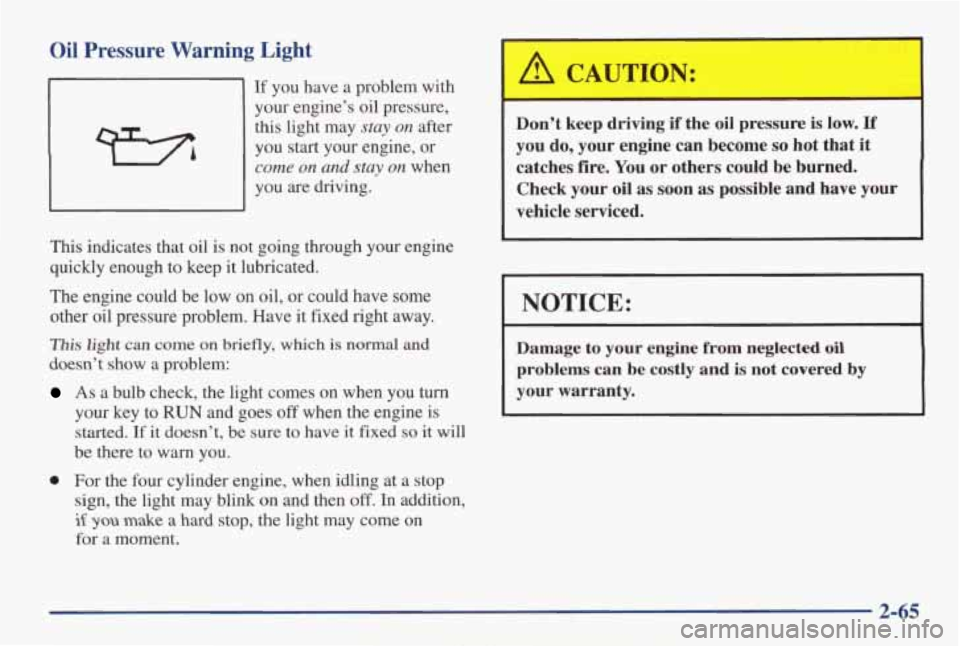
Oil Pressure Warning Light
If you have a problem with
your engineŌĆÖs oil pressure,
this light may
stay on after
you start your engine, or
come on and stay on when
you are driving.
This indicates that oil is not going through your engine
quickly enough to keep it lubricated.
The engine could be low on oil, or could have some
other oil pressure problem. Have it fixed right away.
This light can come on briefly, which is normal and
doesnŌĆÖt show a problem:
As a bulb check, the light comes on when you turn
your key to
RUN and goes off when the engine is
started.
If it doesnŌĆÖt, be sure to have it fixed so it will
be there to warn you.
0 For the four cylinder engine, when idling at a stop
sign, the light may blink on and then
off. In addition,
if you make a hard stop, the light may come on
for a moment.
ŌĆś A CAUTION: I
DonŌĆÖt keep driving if the oil pressure is low. If
you do, your engine can become so hot that it
catches fire. You or others could be burned.
Check your oil as soon
as possible and have your
vehicle serviced.
I NOTICE:
Damage to your engine from neglected oil
problems can be costly and is not covered by
your warranty.
2-65
Page 127 of 370
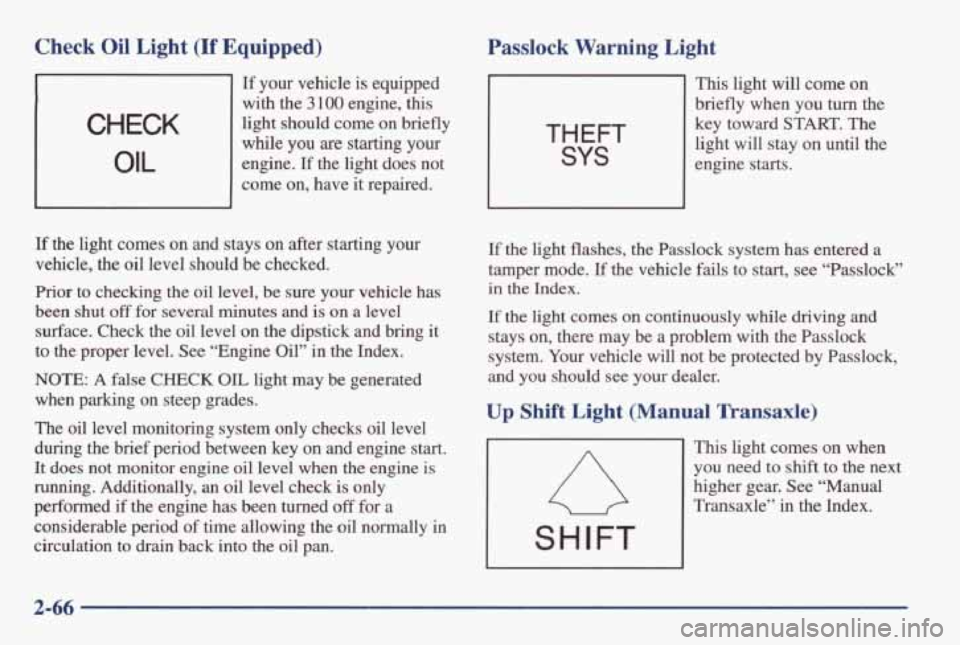
CHECK
OIL
Check Oil Light (If Equipped)
If your vehicle is equipped
with the
3 100 engine, this
light should come
on briefly
while you
are starting your
engine.
If the light does not
come on, have it repaired.
A
If the light comes on and stays on after starting your
vehicle, the oil level should be checked.
Prior to checking
the oil level, be sure your vehicle has
been shut
off for several minutes and is on a level
surface. Check the oil level on the dipstick and bring
it
to the proper level. See ŌĆ£Engine OilŌĆØ in the Index.
NOTE: A false CHECK OIL light may be generated
when parking on steep grades.
The oil level monitoring system only checks oil level
during the brief period between key
on and engine start.
It does not monitor engine oil level when the engine
is
running. Additionally, an oil level check is only
performed if the engine
has been turned off for a
considerable period
of time allowing the oil normally in
circulation to drain back into the oil
pan.
Passlock Warning Light
THEFT
SYS
This light will come on
briefly when you
turn the
key toward
START. The
light will stay on until the
engine starts.
If the light flashes, the Passlock system has entered a
tamper mode. If the vehicle fails to start, see ŌĆ£PasslockŌĆØ
in the Index.
If the light comes on continuously while driving and
stays
on, there may be a problem with the Passlock
system. Your vehicle will not be protected by Passlock,
and you should
see your dealer.
Up Shift Light (Manual Transaxle)
This light comes on when
you need to shift to the
next
higher gear. See ŌĆ£Manual
TransaxleŌĆØ in the Index.
I SHIFT I
2-66
Page 160 of 370
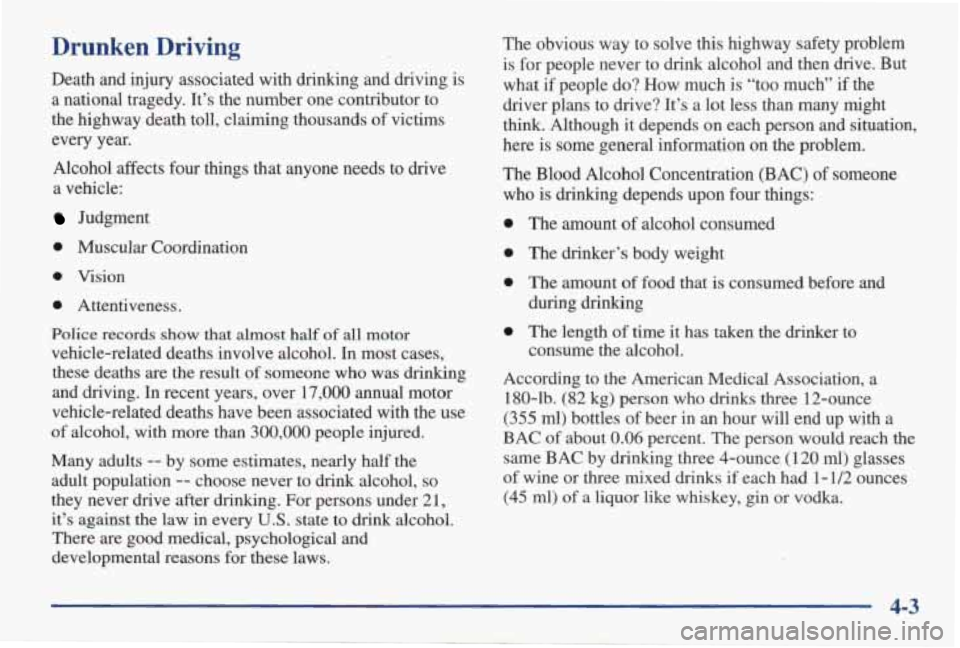
Drunken Driving
Death and injury associated with drinking and driving is
a national tragedy. ItŌĆÖs the number one contributor to
the highway death toll, claiming thousands of victims
every year.
Alcohol affects four things that anyone needs to drive
~
a vehicle:
Judgment
0 Muscular Coordination
0 Vision
0 Attentiveness.
Police records show that almost ha rlf of all motor
vehicle-related deaths involve alcohol. In most cases,
these deaths are the result of someone who was drinking
and driving. In recent years, over 17,000 annual motor
vehicle-related deaths have been associated with the use
of alcohol, with more than
300,000 people injured.
Many adults
-- by some estimates, nearly half the
adult population
-- choose never to drink alcohol, so
they never drive after drinking. For persons under 2 1,
itŌĆÖs against the law in every U.S. state to drink alcohol.
There
are good medical, psychological and
developmental reasons for these laws. The obvious way to solve this highway safety problem
is for
people never to drink alcohol and then
drive. But
what if people do? How much is ŌĆ£too muchŌĆØ if the
driver plans to drive? ItŌĆÖs a lot less than many might
think. Although it depends on each person and situation,
here
is some general information on the problem.
The Blood Alcohol Concentration (BAC) of someone
who is drinking depends upon four things:
0 The amount of alcohol consumed
0 The drinkerŌĆÖs body weight
0 The amount of food that is consumed before and
during drinking
consume the alcohol.
0 The length of time it has taken the drinker to
According to the American Medical Association, a
180-lb. (82 kg) person who drinks three 12-ounce
(355 ml) bottles of beer in an hour will end up with a
BAC of about 0.06 percent. The person would reach the
same
BAC by drinking three 4-ounce (120 ml) glasses
of wine or three mixed drinks if each had
1 - 1/2 ounces
(45
ml) of a liquor like whiskey, gin or vodka.
Page 188 of 370
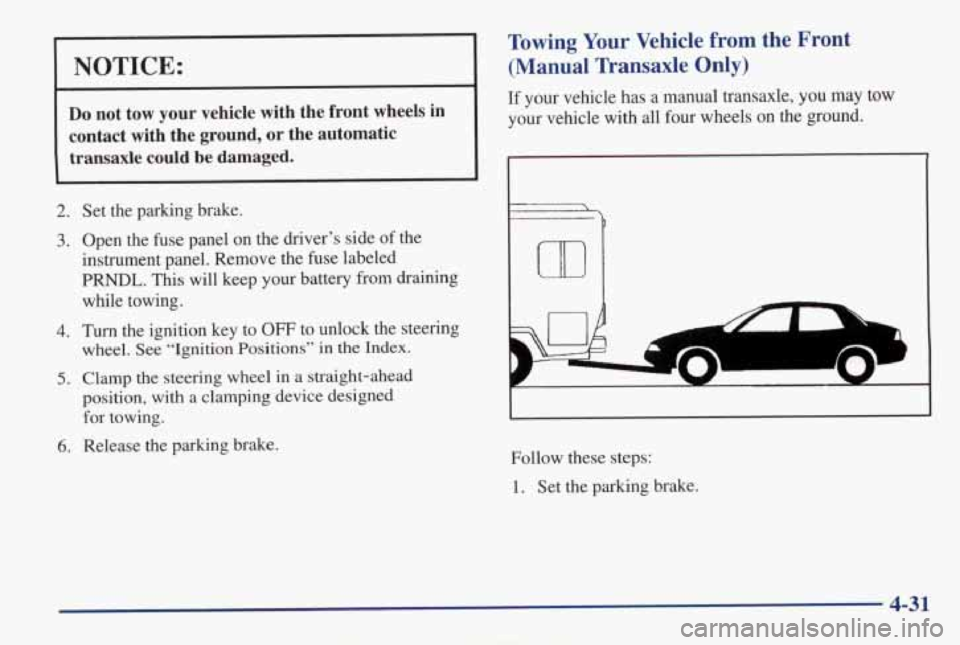
NOTICE:
Do not tow your vehicle with the front wheels in
contact with the ground, or the automatic transaxle could be damaged.
2.
3.
4.
5.
6.
Set the parking brake.
Open the fuse panel on the driverŌĆÖs side of the
instrument panel. Remove the fuse labeled
PRNDL. This will keep your battery from draining
while towing.
Turn the ignition key to OFF to unlock the steering
wheel.
See ŌĆ£Ignition PositionsŌĆØ in the Index.
Clamp the steering wheel in a straight-ahead
position, with a clamping device designed for towing.
Release the parking brake.
Towing Your Vehicle from the Front
(Manual Transaxle Only)
If your vehicle has a manual transaxle, you may tow
your vehicle with all four wheels on the ground.
F
@- I
Follow these steps:
1. Set the parking brake.
4-31
Page 189 of 370
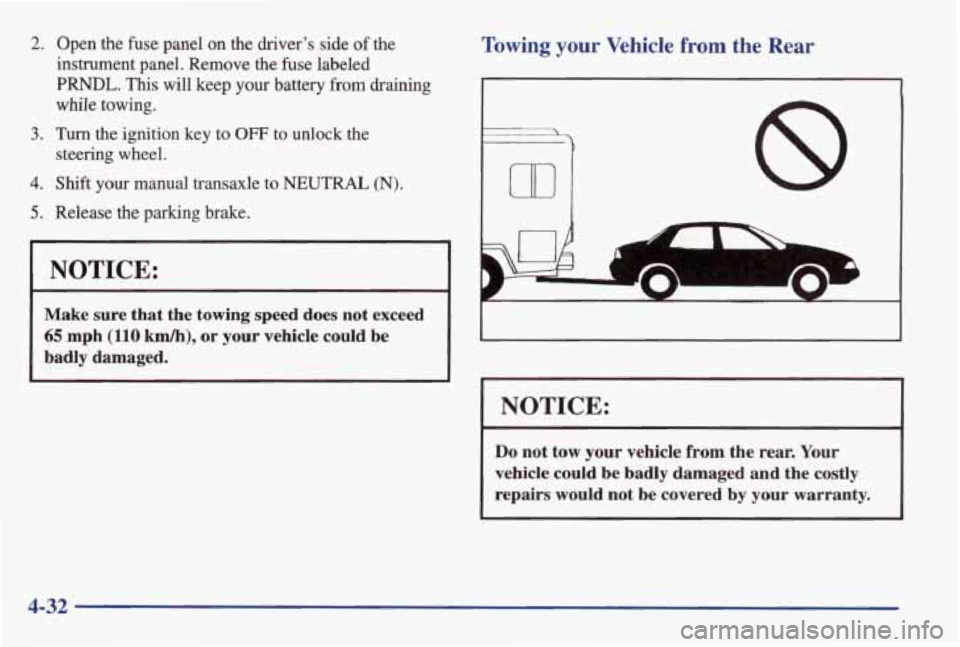
2.
3.
4.
5.
Open the fuse panel on the driverŌĆÖs side of the
instrument panel. Remove the fuse labeled
PWL. This will keep your battery from draining
while towing.
Turn the ignition key to OFF to unlock the
steering wheel.
Shift your manual transaxle to NEUTRAL (N).
Release the parking brake.
.. -
NOTICE:
Make sure that the towing speed does not exceed
65 mph (110 km/h), or your vehicle could be
badly damaged.
Towing your Vehicle from the Rear
b
m 8
c1
5
NOTICE:
Do not tow your vehicle from the rear. Your
vehicle could
be badly damaged and the costly
repairs would not be covered by your warranty.
4-32
Page 201 of 370
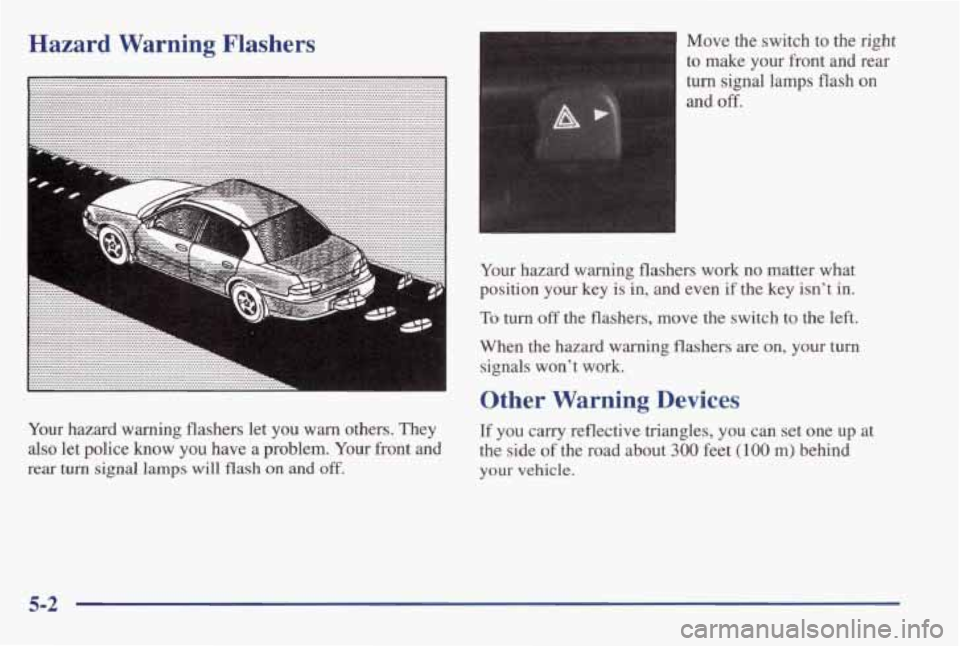
Hazard Warning Flashers
Your hazard warning flashers let you warn others. They
also let police know you have a problem. Your front and
rear turn signal lamps will flash on and off.
Move the switch to the right
:o make your front and rear
iurn signal lamps flash on
and off.
Your hazard warning flashers work no matter what
position your key is in, and even if the key isn't in.
To turn off the flashers, move the switch to the left.
When the hazard warning flashers are on, your turn signals won't work.
Other Warning Devices
If you carry reflective triangles, you can set one up at
the side
of the road about 300 feet (100 m) behind
your vehicle.
5-2
Page 208 of 370
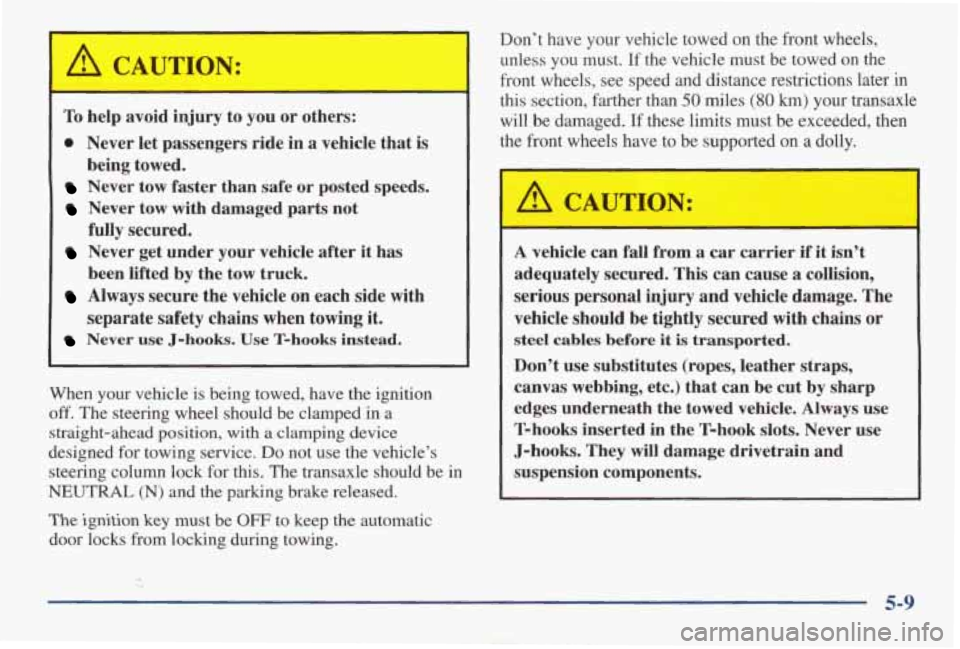
To help avoid injury to you or others:
0 Never let passengers ride in a vehicle that is
Never tow faster than safe or posted speeds.
Never tow with damaged parts not
fully secured.
Never get under your vehicle after it has
been lifted
by the tow truck.
Always secure the vehicle on each side with
separate safety chains when towing it.
Never use J-hooks. Use T-hooks instead.
being towed.
When your vehicle is being towed, have the ignition
off. The steering wheel should be clamped in a
straight-ahead position, with
a clamping device
designed for towing service.
Do not use the vehicleŌĆÖs
steering column lock for this. The transaxle should be
in
NEUTRAL (N) and the parking brake released.
The ignition key must be OFF to keep the automatic
door locks from locking during towing. DonŌĆÖt have your vehicle towed on the
front wheels,
unless you must.
If the vehicle must be towed on the
front wheels, see speed and distance restrictions later
in
this section, farther than 50 miles (80 km) your transaxle
will be damaged.
If these limits must be exceeded, then
the front wheels have to be supported on a dolly.
A vehicle can fall from a car carrier if it isnŌĆÖt
adequately secured.
This can cause a collision,
serious personal injury and vehicle damage. The
vehicle should be tightly secured with chains
or
steel cables before it is transported.
DonŌĆÖt use substitutes (ropes, leather straps,
canvas webbing, etc.) that can be cut
by sharp
edges underneath the towed vehicle. Always use
T-hooks inserted in the T-hook
slots. Never use
J-hooks. They will damage drivetrain and
suspension components.
5-9
Page 210 of 370
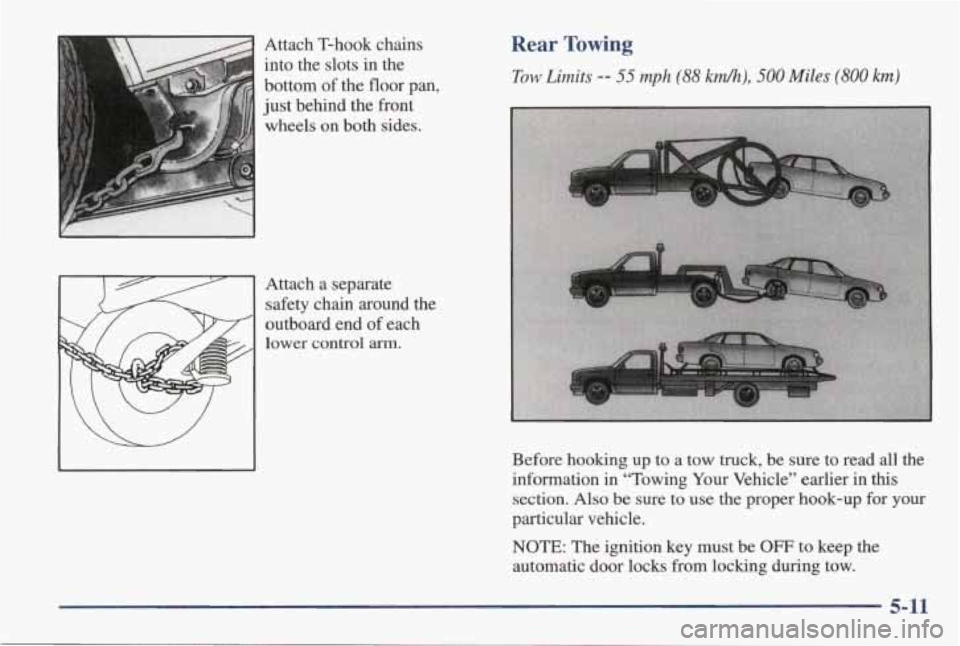
Attach T-hook chains
into the slots in the
bottom
of the floor pan,
just behind the front
wheels on both sides.
Attach a separate safety chain around the
outboard end
of each
lower control arm.
I\ - 1 I
Rear Towing
Tow Limits -- 55 mph (88 kmh), 500 Miles (800 km)
Before hooking up to a tow truck, be sure to read all the
information in ŌĆ£Towing Your VehicleŌĆØ earlier in this
section. Also be sure to use the proper hook-up for your
particular vehicle.
NOTE: The ignition key must be OFF to keep the
automatic door locks
from locking during tow.
5-11
Page 295 of 370
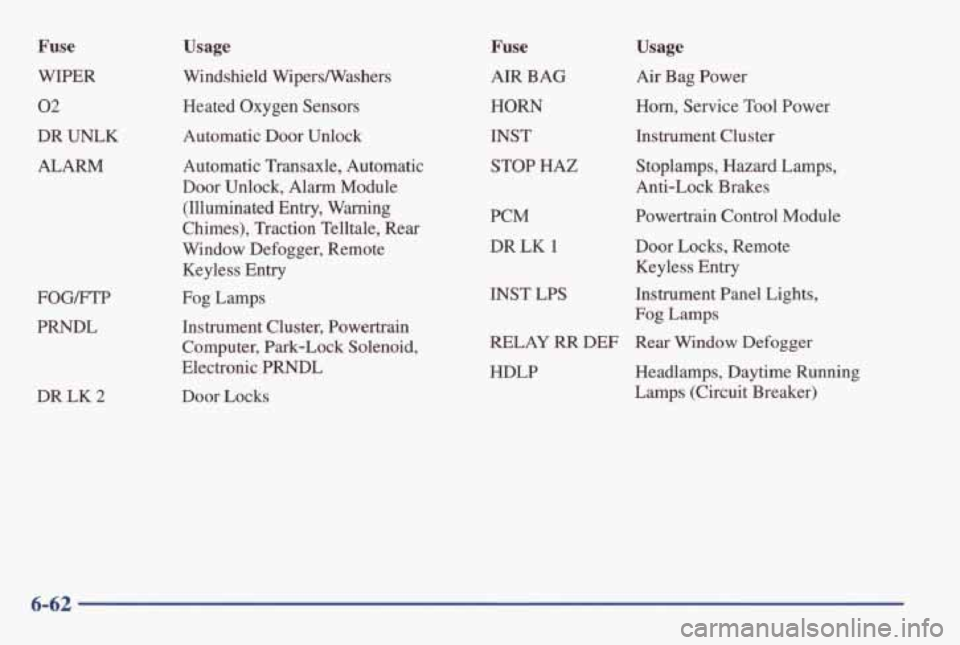
Fuse
WIPER
02
DR UNLK
ALARM
FOG/FTP
PRNDL
DR LK
2
Usage
Windshield Wipersmashers
Heated Oxygen Sensors
Automatic Door Unlock
Automatic Transaxle, Automatic
Door Unlock, Alarm Module (Illuminated Entry, Warning
Chimes), Traction Telltale, Rear
Window Defogger, Remote
Keyless Entry
Fog Lamps
Instrument Cluster, Powertrain
Computer,
Park-Lock Solenoid,
Electronic PRNDL
Door Locks
Fuse
AIR BAG
HORN
INST
STOP HAZ
PCM
DR LK
1
Usage
Air Bag Power
Horn, Service Tool Power
Instrument Cluster
Stoplamps, Hazard Lamps,
Anti-Lock Brakes
Powertrain Control Module
Door Locks, Remote
Keyless Entry
Fog Lamps
INST LPS Instrument Panel Lights,
RELAY RR DEF Rear Window Defogger
HDLP Headlamps, Daytime Running Lamps (Circuit Breaker)
6-62
Page 332 of 370
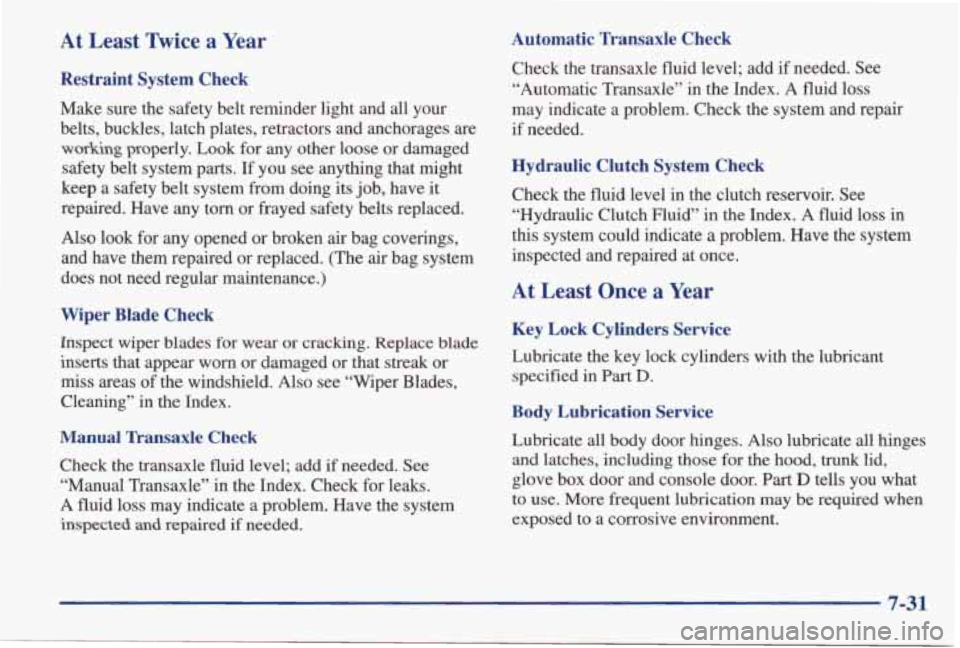
At Least Twice a Year
Restraint System Check
Make sure the safety belt reminder light and all your
belts, buckles, latch plates, retractors and anchorages are
wwking properly. Look for any other loose or damaged
safety belt system parts. If you see anythng that might
keep a safety belt system from doing its job, have it
repaired. Have any torn or frayed safety belts replaced.
Also look for any opened or broken air bag coverings,
and have them repaired or replaced. (The
air bag system
does not need regular maintenance.)
Wiper Blade Check
Inspect wiper blades for wear or cracking. Replace blade
inserts that appear worn or damaged or that streak
or
miss areas of the windshield. Also see ŌĆ£Wiper Blades,
CleaningŌĆØ in the Index.
Manual Transaxle Check
Check the transaxle fluid level; add if needed. See
ŌĆ£Manual TransaxleŌĆØ in the Index. Check for
leaks.
A fluid loss may indicate a problem. Have the system
inspected and repaired if needed.
Automatic Transaxle Check
Check the transaxle fluid level; add if needed. See
ŌĆ£Automatic TransaxleŌĆØ in the Index. A fluid loss
may indicate a problem. Check the system and repair
if needed.
Hydraulic Clutch System Check
Check the fluid level in the clutch reservoir. See
ŌĆ£Hydraulic Clutch FluidŌĆØ in the Index. A fluid loss in
this system could indicate
a problem. Have the system
inspected and repaired at once.
At Least Once a Year
Key Lock Cylinders Service
Lubricate the key lock cylinders with the lubricant
specified in
Part D.
Body Lubrication Service
Lubricate all body door hinges. Also lubricate all hinges
and latches, including those for the hood,
trunk lid,
glove box door and console door. Part
D tells you what
to use. More frequent lubrication may
be required when
exposed to a corrosive environment.
7-31